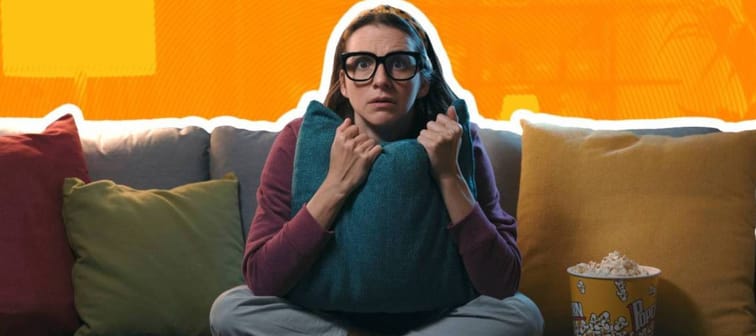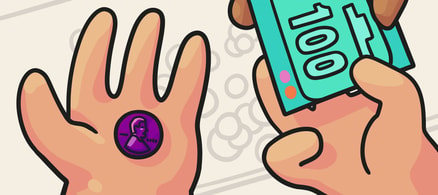1. Deserted locale or haunted house
Whether the destination actually is a cabin in the woods or if the car breaks down in the middle of nowhere, you know nothing good can come of being completely alone in a strange place.
A riff on this idea is the haunted, or abandoned house — the notion that you are completely isolated in the house itself. You’re either trapped by, or trapped in your surroundings.
In Architectural Digest, film historian Leonard Maltin suggests that people continue to be scared by the idea of a haunted house because homes are supposed to be safe places. He believes the longevity of the haunted house trope is due to the fact that the horror comes not from what you see, but from what you don’t see.
If you love a spooky setting, cue up these classics: Amityville Horror, Sinister, or The Changeling.
Meet Your Retirement Goals Effortlessly
The road to retirement may seem long, but with WiserAdvisor, you can find a trusted partner to guide you every step of the way
WiserAdvisor matches you with vetted financial advisors that offer personalized advice to help you to make the right choices, invest wisely, and secure the retirement you've always dreamed of. Start planning early, and get your retirement mapped out today.
Get Started2. “Nobody believes you”
This trope is broader, but tends to feature one character who knows what’s going on but can’t get anyone to listen to what they’re saying.
The “nobody believes you” character can crop up in a few ways. Does one of the characters deal with mental health issues? Is there a strange neighbor who suddenly stumbles into the plot, or an attendant at a rural gas station who tries to give directions to the main characters?
If you’re watching a horror movie and you find someone whose advice is immediately forgotten or ignored, chances are you’ve found the trope.
And the reason why it continues to work is two-fold.
With the strange peripheral character, the psychology behind our pack mentality kicks in. We are social animals, designed to live in groups, and on some level, we are reassured when the “strangeness” of another is pointed out, because it confirms that we’re “normal.” When this pack mentality kicks in amongst the characters on-screen, it can spill over to the audience, who then start to identify with the group.
In terms of the character who lives with mental instability and isn’t believed when they’re telling the truth: Our brains have learned to interpret behavior like averted eyes and being nervous, as lying. As the National Institute of Medicine reports, it is a pervasive societal belief that people who are lying show more nervous behaviors, but it has been proven that that isn’t true.
If you’re intrigued by movies where the central idea is not being believed, try these: Gaslight, Smile, or Gothika.
3. Creepy children
The Shining is a prime example of a “creepy children” movie, in part due to the hallucination Danny Torrance has about the Grady twins in the hallway of the Overlook, but also because of Danny himself. He has psychic abilities, an imaginary friend Tony who lives in his finger, and has terrifying visions.
His talents for “shining” stand out even more because Danny is so young (the character is only five years old), gentle, and passive. It’s this sweetness that often seems to set off his father’s alcoholic rages.
Other classic horror movies with creepy children in them include Poltergeist, and Children of the Corn.
Although each of these movies has a different take on the trope, Vice suggests creepy children are perennially spooky because we often perceive kids to be innocent and pure of heart, and it’s unsettling to be proven so wrong.
Kiss Your Credit Card Debt Goodbye
Having a single loan to pay off makes it easier to manage your payments, and you can often get a better interest rate than what you might be paying on credit cards and car loans.
Fiona is an online marketplace offering personalized loan options based on your unique financial situation.
When you consolidate your debt with a personal loan, you can roll your payments into one monthly installment. Find a lower interest rate and pay down your debt faster today.
Get Started4. The dream
Most of us have had nightmares, which makes this horror movie premise extra-terrifying. If our brains can imagine something, it can happen in our dreams. Horror movies tend to take this idea a lot further, allowing dreams to cross over into reality.
The ultimate dream villain in recent memory is Freddy Krueger of the Nightmare on Elm Street series, who can actually kill his victims in their dreams.
According to Industrial Scripts, dream sequences in horror movies continue to scare audiences because dreaming is something we all do, and because most of us can’t control what we dream about.
That lack of control, combined with the infinite possibility of the human imagination, provides an irresistible template for horror directors.
If we’ve only whetted your appetite for films about disturbing dreams, here are a few more suggestions: Last Night in Soho, Jacob’s Ladder, The Cell.
5. Demonic possession
Demonic possession, seen in movies like The Exorcist — where Regan MacNeil becomes a human host for an ancient demon — has long been a feature of most religions, reports The Wall Street Journal (WSJ).
Teenagers in particular, who have historically been the target audience for horror films, are susceptible to the idea that unseen forces can take over their bodies. (Hormones, anyone?)
But fears regarding demons and possession aren’t limited to religions; WSJ calls it a primal fear that goes back thousands of years.
Movies about demonic possession often resonate with audiences who are worried about the moral decay happening in society and are looking for an explanation.
If you want to watch some genre-defining movies about demonic possession, start with Rosemary’s Baby. A 21st century take on the subject would be Jennifer’s Body.
6. One final scare
You’ve survived two adrenaline-racing hours of a horror movie and it’s just about over: The antagonist has been killed or corralled, and the protagonists are limping away into the sunset. Then, just before the credits roll, the screen blares and a disembodied hand sticks up from the earth of a freshly dug grave.
While final scares can often be cliché, the movies that do it the best — like 2018’s Hereditary, or 2019’s Midsommar, provide an extra twist to the twistiest of film genres.
Not only does the final scare set up the possibility of a sequel (or better yet, a franchise), but it imprints the movie into the viewer’s memory while inverting the typical “happy endings” we’re used to.
If you want to watch a movie where the scares won’t stop until the theater lights go up, these are “safe” bets: Carrie, Rec, and Don’t Look Now.
7. The Final Girl
The final girl is typically the protagonist of the movie — and the only one to escape death and destruction. Final girls are the characters who notice details and begin to put things together.
The epitome of the “final girl” trope is Laurie Strode, the babysitter who fights off Michael Myers until the bitter end in 1978’s Halloween.
According to Vox, the term “final girl” was coined in the 1992 book Men, Women, and Chainsaws. They tend to be “nice girls”; dependable, trustworthy and the moral center of their group.
Over the course of the movie, the audience begins to root for their survival. The final girl always has a last confrontation with the antagonist of the film, subduing or vanquishing them in some way.
While the final girl can also veer into cliché territory, she has endured because horror audiences tend to love a good survival story.
If you want a happy ending with your horror (at least for one girl), cue these up: The Texas Chainsaw Massacre, Scream, or Friday the 13th.
The trope antidote
Tropes can easily be clichés, because they are used so often; but like clichés, there is truth in them — truth in what they expose about our humanity. There is also truth that, if done well, they will continue to scare audiences for a long time to come.
If you’ve never been able to watch horror movies but are curious about them, Refinery 29 has some tips on how you can steel yourself for a screening. For instance, there is no shame in looking up spoilers online before you go, or closing your eyes at the scenes you’re finding challenging.
If you are interested in horror movies that turn the “regular” tropes inside out, then here are a couple films that will help you scratch that itch:
- The Witch — If blood and gore isn’t your thing, then try psychological horror. The Witch takes place in the 1600s and is about a Puritan family who encounter an evil presence in the woods behind their home.
- Scream 5 — The fifth movie in the franchise takes place 25 years after the first one, and stars a lot of the original actors. It stabs a pin into the balloons of multiple horror tropes, like: Never trust the love interest, the killer’s motives are always connected to something you did in your past and don’t go downstairs. Rotten Tomatoes says that the movie is trying extra hard to maintain its meta edge, and succeeds most of the time.
- For your ultimate meta, movie-viewing pleasure, try The Final Girls. It’s not just a trope, it’s a movie, too. The Final Girls seems to mow down every stereotype it encounters: The main character, grieving the loss of her mother (who had been a 1980s “scream queen”), finds herself trapped in her mother’s most famous horror film — which takes place at a summer camp. The movie-within-the-movie plays with other tropes, too, and somehow manages to inject a bit of humor into the terror. As Screen Rant says in its review, the movie’s self-awareness is transcendent enough, but allowing its “final girls” to survive is the “piece de resistance.”
Sponsored
Follow These Steps if you Want to Retire Early
Secure your financial future with a tailored plan to maximize investments, navigate taxes, and retire comfortably.
Zoe Financial is an online platform that can match you with a network of vetted fiduciary advisors who are evaluated based on their credentials, education, experience, and pricing. The best part? - there is no fee to find an advisor.







